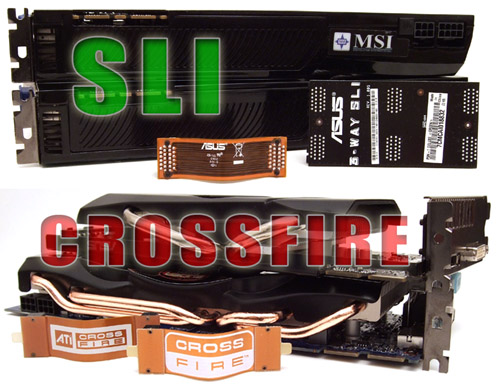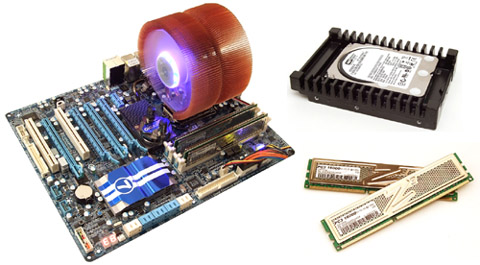Multi-GPU Setups: The Basics Of CrossFire And SLI
Motherboards with multiple PCIe slots are becoming the norm these days, and the trend is being fueled by multi-GPU configurations. Configuring Nvidia's SLI and AMD's CrossFire technologies is easy, but how much more performance can you expect from them?
AMD Or Nvidia?
AMD calls it CrossFire, Nvidia calls it Scalable Link Interface (SLI). In essence, both companies are using a similar concept to distribute the workload presented by your favorite game across two, three, or four graphics cards.
Installing a multiple graphics card setup can be a bit tricky, and there are several questions you need to answer. How fast must the PCI Express slots be (we'll have a story posted next week addressing this one in depth)? Do you need a bridge connector between the cards? How powerful should the CPU be to make proper use of this graphics muscle? We asked ourselves these questions, ran scaling tests, compiled the results, and came up with some great tips for you.
In order to evaluate how SLI and CrossFire scale with CPU performance, we increased the default 2.66 GHz clock rate (133 MHz x 20) of our Intel Core i5-750 reference processor to almost 4 GHz (190 MHz x21) by modifying the base clock and multiplier in the BIOS. On all Intel processors with Turbo Boost feature (that aren't Extreme Edition or K-series parts), you can only increase the multiplier by one increment. We used a Gigabyte P55A-UD7 motherboard and disabled Turbo Boost. The number of CPU cores remained unchanged.
Unlike many other platforms, which are limited to CrossFire, our our P55-based Gigabyte board supports both CrossFire and SLI, making it easier to keep the platform consistent.
| Nvidia and AMD Graphics Test Setup | |
|---|---|
| CPU | Intel Core i5-750 @ 4 GHz (190 MHz x 21), Lynnfield, BIOS 1.26875 V, 45 nm, LGA 1156 |
| Motherboard | Gigabyte P55A-UD7, PCIe 2.0, 3-Way SLI, SATA 6Gb/s, USB 3.0 |
| Chipset | Intel P55 Express |
| Memory | OCZ3G2000LV4GK, PC3-16000 Golden Series, 2 x 2 GB DDR3, 2 x 570 MHz 7-7-7-19 |
| Audio | Realtek ALC889 |
| LAN | 2 x RTL8111D |
| HDDs | SATA, Western Digital, Raptor WD300HLFS, WD5000AAKS |
| DVD | Gigabyte GO-D1600C |
| Power Supply | Cooler Master RS-850-EMBA 850 W |
| Drivers and Configuration | |
| Graphics | AMD Catalyst 10.4, Geforce 197.45 |
| Operating System | Windows 7 Ultimate 32-Bit |
| DirectX | 9, 10, and 11 |
| Chipset Driver | Intel Chipset Installation Utility 9.1.1 |
Get Tom's Hardware's best news and in-depth reviews, straight to your inbox.
-
ramcrazy360 It's great to know there's so little difference between 8x and 16x preformance even with a 5850! I was worried about having a bandwidth issue with two 5770s, but it seems that won't be a problem.Reply -
Maziar Great review,however i wish you tested on resolutions like 2560x1600 and higher,because i think the main difference between 8x and 16x is in resolutions like that.Reply -
wildeast same as ramcrazy,Reply
i was going to get an i5 but that means a p55 mobo (x8+x8) not x58 (x16+x16), so i thought i should be getting x58 and i7 rig which is beyond my savings, thnx tom's am getting i5 + p55 now :) -
Tamz_msc Very nice article.It cleared a lot of confusion in my case.I would have liked to see scaling with increase in the number of CPU cores.Reply -
ruffopurititiwang Great article! Now we know what the deal is regarding multi-gpu and PCI-E lane speeds with mainstream setups.Reply
Now how about showing some love for top of the line setups? Can you apply the same tests to GTX 480/ATI 5870 Multi-gpu configuration + X58 mobo & 980X proc? -
rohitbaran On page 7, performance of Radeons in Alien vs Predator is not arranged properly with CPU speed.Reply -
lothdk rohitbaranOn page 7, performance of Radeons in Alien vs Predator is not arranged properly with CPU speed.Reply
All the tests are arranged by GPU performance not by CPU speed. -
TheStealthyOne I'll definitely be using this article as a reference for a dual 5850 machine I'm building :)Reply -
hixbot In every single TOMS article showing benches on CPU scaling, you use High resolutions with FULL AA and aniso! WHY?!Reply
I know thats how many would play the game, and it shows the performance that one would expect with different CPUs. It shows that we don't need to overclock or buy expensive CPUs, when the load (bottleneck) is on the GPU.
BUT if you would also show the CPU scaling in low resolutions and no AA/aniso, we could see how the CPUs might stack up. This is valuable for knowing how the CPUs perform in the future, when one might have upgraded the GPUs, and the bottleneck dissapears.
Yeah, yeah, this is not a CPU article... i know but still.. it shows CPU scaling, and every time I see CPU scaling demonstrated on toms, it's shown with a bottleneck on the GPU.
Humour us next time and include a bench or two with no GPU bottlneck (low res, eye candy). Just becaause that's not how we'd play the game, and just because the FPS would be insanely high, doesn't mean the numbers wouldn't be valuable. I complain about this in every article that includes CPU scaling.
It doesn't erk me that much here because this article isn't focused on CPUs. but for the love god, the next CPU article you do, when you test gaming, throw a bench or two in there with very low settings.

